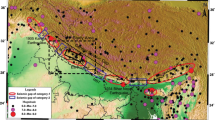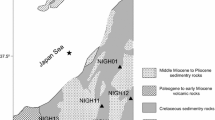The Iwate–Miyagi earthquake (Mw 6.9) of 14 June 2008 is one of the largest intraplate earthquakes that struck north-east Japan. This earthquake has produced the largest peak ground acceleration (PGA) ever recorded. The acceleration values 4022 and 1036 gal were observed at the surface and borehole accelerometers of IWTH25. To understand the cause of this extremely large acceleration, it is highly essential to obtain the detailed rupture process of Iwate–Miyagi earthquake. The present paper estimates the rupture model for this earthquake using the modified semi-empirical technique (MSET). The detailed analysis proposes one strong motion generation area (SMGA) in the rupture plane and nucleation point in the extreme western corner of the SMGA. Using this estimated source model, a satisfactory match is observed between the simulated and actual records. The quantitative analysis of these waveforms provides an almost 1:1 match for PGA values. Furthermore, the variation of these PGA values with epicentral distance shows similar attenuation rate. These results confirm the reliability of MSET and the estimated source model of this earthquake. To the best of our knowledge, this study is the first to model SMGAs in the rupture model using MSET and provides sufficiently reliable information which will be useful for seismic hazard prevention management.














Similar content being viewed by others
References
Aki K 1967 Scaling law of seismic spectrum; J. Geophys. Res. 72 1217–1231.
Asano K and Iwata T 2012 Source model for strong ground motion generation in 0.1–10 Hz during the 2011 Tohoku earthquake; Earth Planet. Space 64(12) 1111–1123.
Boore D M 1983 Stochastic simulation of high frequency ground motion based on seismological models of radiated spectra; Bull. Seismol. Soc. Am. 73 1865–1894.
Boore D M and Bommer J 2005 Processing of strong motion accelerograms: Needs, options and consequences; Soil Dyn. Earthq. Eng. 25 93–115.
Brune J N 1970 Tectonic stress and spectra of seismic shear waves from earthquakes; J. Geophys. Res. 75 4997–5009.
Hikima K, Miyazaki S and Koketsu K 2008 Rupture process of the 2008 Iwate–Miyagi Nairiku Earthquake (Mj 7.2), Japan; inferred from strong motion and geodetic data, American Geophysical Union, Fall Meeting 2008, abstract id. S51D-1789.
Irikura K and Kamae K 1994 Estimation of strong ground motion in broad-frequency band based on a seismic source scaling model and an empirical Green’s function technique; Ann. Geofis. XXXVII(6) 1721–1743.
Irikura K, Kagawa T and Sekiguchi H 1997 Revision of the empirical Green’s function method by Irikura, 1986; Programme and Abstracts, The Seismological Society of Japan, Vol. 2, B25p.
Irikura K and Miyake H 2011 Recipe for predicting strong ground motion from crustal earthquake scenarios; Pure Appl. Geophys. 168 85–104.
Joshi A 2001 Strong motion modeling of the source of the Chamoli earthquake of March 29, 1999 in the Garhwal Himalaya, India; J. Seismol. 5 499–518.
Joshi A 2004 A simplified technique for simulating wide band strong ground motion for two recent Himalaya earthquakes; Pure Appl. Geophys. 161 1777–1805.
Joshi A and Patel R C 1997 Modelling of active lineaments for predicting a possible earthquake scenario around Dehradun, Garhwal Himalaya, India; Tectonophys. 283 289–310.
Joshi A, Kumar B, Sinvhal A and Sinvhal H 1999 Generation of synthetic accelerograms by modelling of rupture plane; J. Earthq. Technol. 36 43–60.
Joshi A, Singh S and Giroti K 2001 The simulation of ground motions using envelope summations; Pure Appl. Geophys. 158 877–901.
Joshi A and Midorikawa S 2004 A simplified method for simulation of strong ground motion using rupture model of the earthquake source; J. Seismol. 8 467–484.
Joshi A, Kumari P, Sharma M L, Ghosh A K, Agarwal M K and Ravikiran A 2012a A strong motion model of the 2004 great Sumatra earthquake: Simulation using a modified semi empirical method; J. Earthq. Tsunami 6 1–29.
Joshi A, Kumari P, Singh S and Sharma M L 2012b Near-field and far-field simulation of accelerograms of Sikkim earthquake of September 18, 2011 using modified semi-empirical approach; Nat. Hazards 64 1029–1054.
Joshi A, Sandeep and Kamal 2014 Modeling of strong motion generation areas of the 2011 Tohoku, Japan earthquake using modified semi empirical technique; Nat. Hazards 71 587–609.
Joshi A, Kuo C H, Dhibar P, Sandeep, Sharma M L, Wen K L and Lin C M 2015 Simulation of the records of the 27th March 2013, Nantou Taiwan earthquake using modified semi-empirical approach; Nat. Hazards 78 995–1020.
Kamae K and Kawabe H 2004 Source model composed of asperities for the 2003 Tokachi-oki, Japan, earthquake (MJMA = 8.0) estimated by the empirical Green’s function method; Earth Planet. Space 56 323–327.
Kameda H and Sugito M 1978 Prediction of strong earthquake motions by evolutionary process model; In: Proceedings of the sixth Japan earthquake engineering symposium, pp. 41–48.
Kanamori H and Anderson D L 1975 Theoretical basis of some empirical relations in seismology; Bull. Seismol. Soc. Am. 65 1073–1095.
Kato N 2012 Dependence of earthquake stress drop on critical slip-weakening distance; J. Geophys. Res. 117 1–10.
Kiyono J 1992 Identification and synthesis of seismic ground motion in structural response analysis; PhD Thesis, Department of Civil Engineering Kyoto University.
Kumar D, Teotia S S and Khattari K N 1997 The representation of attenuation characterstics of strong ground motion observed in the 1996 Dharamshala and 1991 Uttarkasshi earthquakes by available empirical relations; Curr. Sci. 73 543–548.
Kumar R, Sumathi P and Kumar A 2016 A time-frequency approach for generation of synthetic time-histories of earthquake signals, Springer; Acta Geodaet. Geophys. 51(1) 57–67.
Kurahashi S and Irikura K 2011 Source model for generating strong ground motions during the 2011 off the Pacific coast of Tohoku earthquake; Earth Planet. Space 63 571–576.
Midorikawa S 1989 Synthesis of ground acceleration of large earthquakes using acceleration envelope waveform of small earthquake; J. Struct. Construct. Eng. 398 23–30.
Midorikawa S 1993 Semi empirical estimation of peak ground acceleration from large earthquakes; Tectonophys. 218 287–295.
Miyahara M and Sasatani T 2004 Estimation of source process of the 1994 SanrikuHaruka–oki earthquake using empirical Green’s function method; Geophys. Bull. Hokkaido Univ. Sapporo Japan 67 197–212 (in Japanese with English abstract).
Miyake H, Iwata T and Irikura K 1999 Strong ground motion simulation and source modeling of the Kagoshima–ken Hokuseibu earthquakes of March 26 (MJMA 6.5) and May 13 (MJMA 6.3), 1997, using empirical Green’s function method; Zisin 51 431–442.
Miyake H, Iwata T and Irikura K 2001 Estimation of rupture propagation direction and strong motion generation area from azimuth and distance dependence of source amplitude spectra; Geophys. Res. Lett. 28(14) 2727–2730.
Miyake H, Iwate T and Irikura K 2003 Source characterization for broadband ground-motion simulation: Kinematic heterogeneous source model and strong motion generation area; Bull. Seismol. Soc. Am. 93 2531–2545.
Sandeep, Joshi A, Kamal, Kumar P and Kumar A 2014a Effect of frequency dependent radiation pattern in simulation of high frequency ground motion of Tohoku earthquake using modified semi empirical method; Nat. Hazards 73 1499–1521.
Sandeep, Joshi A, Kamal, Kumar P and Kumari P 2014b Modeling of strong motion generation area of the Uttarkashi earthquake using modified semi-empirical approach; Nat. Hazards 73 2041–2066.
Sandeep, Joshi A, Kamal, Kumar P, Kumar A and Dhibar P 2015 Modeling of strong motion generation areas of the Niigata, Japan, earthquake of 2007 using modified semi empirical technique; Nat. Hazards 77 933–957.
Sandeep, Joshi A, Kumari P, Lal S, Vandana, Kumar P and Kamal 2017a Emergence of the semi-empirical technique of strong ground motion simulation: A review; J. Geol. Soc. India 89 719–722.
Sandeep, Joshi A, Sah S K, Kumar P, Lal S, Vandana, Kamal and Singh R S 2017b Source model estimation of the 2005 Kyushu earthquake, Japan using modified semi empirical technique; J. Asian Earth Sci. 147 240–253.
Sandeep, Joshi A, Lal S, Kumar P, Vandana, Sah S K and Kamal 2017c Simulation of strong ground motion of the 2009 Bhutan earthquake using modified semi empirical technique; Pure Appl. Geophys. 174 4343–4356.
Sandeep, Joshi A, Sah S K, Kumar P, Lal S and Kamal 2019 Modelling of strong motion generation areas for a great earthquake in central seismic gap region of Himalayas using the modified semi-empirical approach; J. Earth Syst. Sci., https://doi.org/10.1007/s12040-019-1126-5.
Seismosoft 2002 SeismoSignal – A computer program for signal processing of time-histories; www.seismosoft.com.
Suzuki W and Iwata T 2007 Source model of the 2005 Miyagi-Oki, Japan, earthquake estimated from broadband strong motions; Earth Planet. Space 59 1155–1171.
Suzuki W, Aoi S and Sekiguchi H 2010 Rupture process of the 2008 Iwate–Miyagi Nairiku, Japan, earthquake derived from near-source strong-motion records; Bull. Seismol. Soc. Am. 100(1) 256–266.
Takiguchi M, Asano K and Iwate T 2011 The comparison of source models of repeating subduction-zone earthquakes estimated using broadband strong motion records–1982 and 2008 Ibaraki–ken–oki M7 earthquakes; J. Seismol. Soc. Japan 63 223–242 (in Japanese with English abstract).
Ukawa M, Ishida M, Matsumura S and Kasahara K 1984 Hypocenter determination method of the Kanto–Tokai observational network for microearthquakes; Rep. Nat’l. Res. Cent. Disaster Prev. 53 1–88 (in Japanese with English abstract).
Wells L D and Coppersmith K J 1994 New empirical relationships among magnitude, rupture length, rupture width, rupture area and surface displacement; Bull. Seismol. Soc. Am. 84 974–1002.
Acknowledgements
Sandeep is grateful to Prof N P Singh for his valuable suggestions and the Department of Geophysics, Banaras Hindu University, Varanasi for providing the basic research facility. Dr Preeti is thankfully acknowledged for her efforts on improving the quality of manuscript. Data employed in this work were obtained from the KiK-net (website http://www.k-net.bosai.go.jp/k-net/ and USGS (website http://www.usgs.gov/). This research work is a result of the sponsored project ECR/2016/000737 from the Science and Engineering Research Board, DST. PK acknowledges the director of Wadia Institute of Himalayan Geology, Dehradun.
Author information
Authors and Affiliations
Corresponding author
Additional information
Communicated by Piyush Shanker Agram
Rights and permissions
About this article
Cite this article
Sandeep, Joshi, A., Devi, S. et al. Strong motion generation area modelling of the 2008 Iwate earthquake, Japan using modified semi-empirical technique. J Earth Syst Sci 128, 202 (2019). https://doi.org/10.1007/s12040-019-1221-7
Received:
Revised:
Accepted:
Published:
DOI: https://doi.org/10.1007/s12040-019-1221-7




